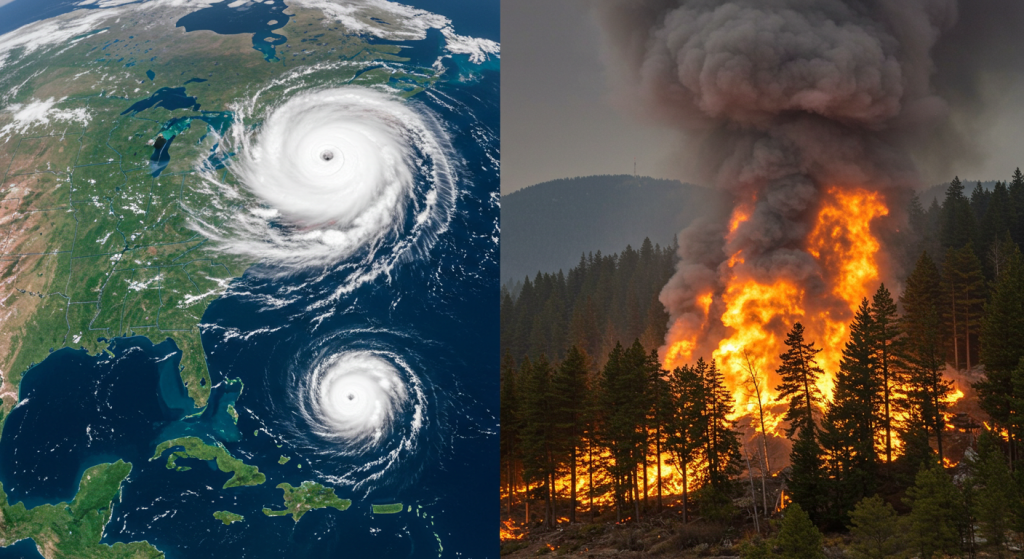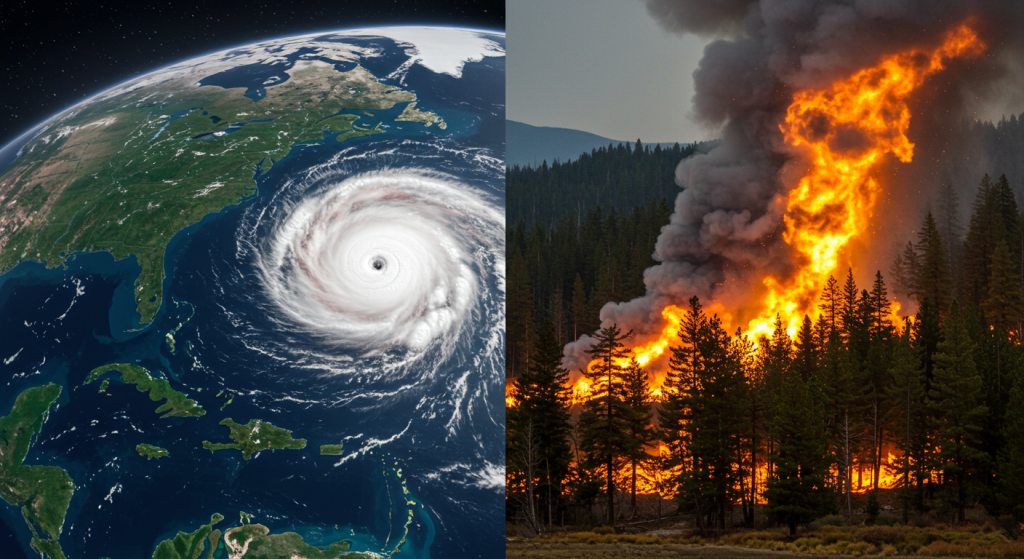Extreme weather events have become a defining feature of the United States’ climate landscape, with increasing frequency and intensity in recent years. From hurricanes battering the Gulf Coast to wildfires scorching the West, these events disrupt lives, damage infrastructure, and strain economies. This blog post explores the major types of extreme weather events impacting the USA, their causes, and their consequences, while offering a glimpse into how communities are adapting.

Hurricanes: Coastal Chaos
Hurricanes are among the most destructive weather events in the USA, particularly affecting states along the Atlantic and Gulf coasts. In 2024, the National Oceanic and Atmospheric Administration (NOAA) reported an above-average hurricane season, with 17 named storms, 10 hurricanes, and 5 major hurricanes (Category 3 or higher). Hurricane Helene, a Category 4 storm, caused catastrophic flooding in the Southeast, with damages estimated at over $40 billion. These storms bring powerful winds, storm surges, and torrential rains, often leading to widespread power outages and property destruction.
The warming climate, driven by human activities like burning fossil fuels, is intensifying hurricanes. Warmer ocean waters fuel stronger storms, while rising sea levels exacerbate storm surges. Coastal communities are responding with improved early warning systems, stricter building codes, and investments in natural barriers like wetlands to mitigate flooding.
Wildfires: A Growing Western Threat
In the Western USA, wildfires have become a near-annual crisis. In 2024, over 7 million acres burned across states like California, Oregon, and Washington, according to the National Interagency Fire Center. The Park Fire in California, one of the largest in state history, scorched nearly 430,000 acres. Drought, high temperatures, and strong winds create tinderbox conditions, while decades of fire suppression have left forests overgrown and prone to catastrophic burns.

Climate change plays a significant role, extending drought periods and increasing heatwaves. Human activities, like power line malfunctions or campfires, often ignite these blazes. Communities are adapting through controlled burns, fire-resistant landscaping, and evacuation planning, but the scale of the challenge is immense.
Tornadoes: The Midwest’s Twisters
The Midwest, often called “Tornado Alley,” faces frequent and violent tornadoes. In 2024, the USA saw over 1,200 tornadoes, with clusters in Oklahoma, Kansas, and Missouri, per NOAA’s Storm Prediction Center. These storms can level homes and businesses in minutes, with winds exceeding 200 mph in the strongest cases. The 2024 Joplin tornado outbreak, for instance, caused significant damage and loss of life.
Warmer, moist air from the Gulf of Mexico, clashing with cooler northern air, fuels these storms. Climate models suggest tornado seasons may lengthen as global temperatures rise. Improved Doppler radar and storm shelters are helping, but rural areas remain vulnerable.
Floods and Droughts: Extremes in Balance
Floods and droughts represent opposite ends of the water spectrum but are equally devastating. The Midwest and Northeast faced record-breaking floods in 2024, with the Mississippi River basin seeing historic water levels. Meanwhile, the Southwest endured prolonged droughts, with the Colorado River’s dwindling reserves threatening water supplies for millions.
These extremes are linked to shifting precipitation patterns, driven by climate change. Heavy rain events are becoming more intense, while dry regions face longer rainless periods. Water management strategies, like reservoir optimization and flood-resistant infrastructure, are critical adaptations.
Looking Ahead: Adaptation and Resilience
Extreme weather events are a stark reminder of the USA’s vulnerability to a changing climate. Federal and state governments are investing in resilient infrastructure, from elevated roads to advanced weather forecasting. Communities are embracing green solutions, like reforestation and urban cooling centers, to mitigate impacts. However, the scale of these events demands collective action—reducing greenhouse gas emissions, supporting affected regions, and preparing for a future where extremes may become the norm.



